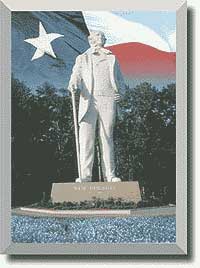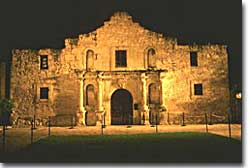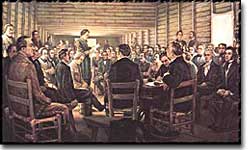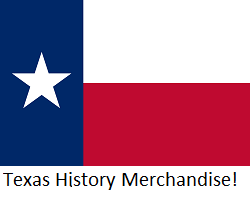29a. The Lone Star Republic

At the time Spain granted independence to Mexico in 1821, the land now comprising the state of Texas was very sparsely populated. The Mexican government actually encouraged the settlement of the area by American pioneers.
In 1823, Stephen Austin led 300 American families onto land granted to his father by the Mexican government. A prosperous province was greatly in the interest of Mexico, so no alarm was raised. Mexico was also interested in creating a buffer zone between the Mexican heartland and the Comanche tribe.
There were, however, strings attached.
The American settlers were expected to become Mexican. All immigrants from the United States were by law forced to become Catholic. When the Mexican government outlawed slavery in 1829, it expected the Texans to follow suit. None of the conditions were met, and a great cultural war was underway.

Today the Alamo is also known as the "Shrine of Texas Liberty."
In the hopes of easing tensions, Stephen Austin journeyed to Mexico City in 1833. But Mexico's dictator, Santa Anna, was not the negotiating type. Austin was simply thrown in jail. Although he was released after 18 months, relations between the Texans and the Mexicans deteriorated. Finally in 1835, war broke out between Santa Anna's troops and a ragtag group of Texan revolutionaries. On March 2, 1836, representatives from Texas formally declared their independence. Four days later, Santa Anna completed an infamous siege on the Alamo mission.
Despite a 13-day holdout, the 187 Texans were crushed by Santa Anna's forces, which numbered 5000 strong. The deaths of commander William Travis, Jim Bowie, and Davy Crockett angered Americans as cries of "Remember the Alamo!" rang throughout the land. Americans flocked to Texas, and, led by commander Sam Houston, defeated Santa Anna's forces. On May 14, 1836, Santa Anna grudgingly recognized Texan independence.

On March 1, 1836, while the Battle of the Alamo raged miles away, 59 men signed Texas's Declaration of Independence.
Texan-Americans were not the only ones fighting for independence. The Tejano people, Spanish-speaking settlers of Texas, also supported the Texas Revolution. They had hoped for greater control over their local affairs. They fought side-by-side with Houston's troops against Santa Anna's soldiers. After the war, there was quite a bit of disillusionment. The Americans who swarmed into Texas did not distinguish between Tejanos and Mexicans. In the decade that followed, the Tejanos found themselves shut out of the new Texas government as well.
Most Texan-Americans wanted to be annexed by the United States. They feared that the Mexican government might soon try to recapture their land. Many had originally come from the American south and had great interest in becoming a southern state. President Andrew Jackson saw trouble. Many Whigs and Abolitionists in the North refused to admit another slave state to the Union. Rather than risk tearing the nation apart over this controversial issue, Jackson did not pursue annexation. The Lone Star flag flew proudly over the Lone Star Republic for nine years.
Texas was an independent country.





